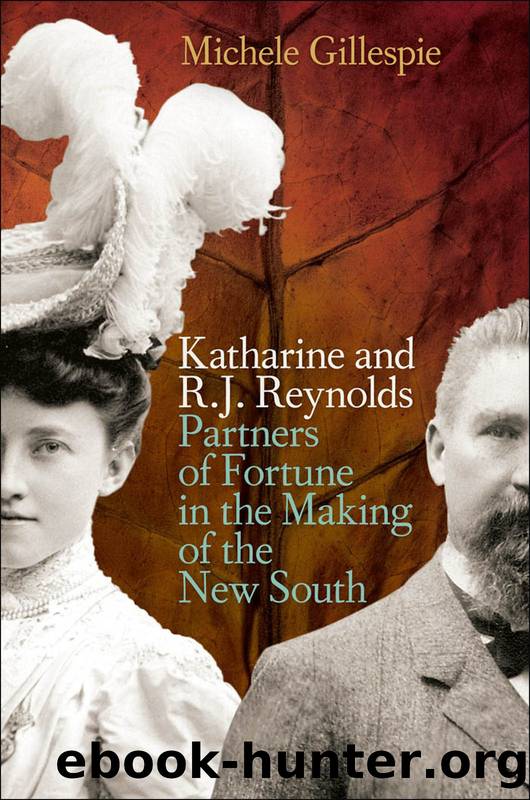Katharine and R. J. Reynolds by Michele Gillespie

Author:Michele Gillespie
Language: eng
Format: epub
ISBN: 978-0-8203-4465-2
Publisher: University of Georgia Press
Published: 2012-09-30T16:00:00+00:00
It was in this changing climate that R.J.R. introduced his Camel cigarette in 1913, one of four new brands he was test-marketing at a time when cigarette smokers were still few and far between. By late 1912, R.J.R. was buying cigarette machines. By early 1913, he told the Winston Board of Trade that he would be producing cigarettes. Eager to capture a national market, just as he had with Prince Albert, he played with the same blends that had made “the national joy smoke” so popular—plentiful burley, a generous smattering of bright leaf, and 10 percent Turkish. The formula took the bite out of straight Turkish blends but retained enough exoticism to capture people’s taste buds and imaginations. Turkish cigarettes were virtually unknown in the United States before the appearance of the Camel. In contrast, the La Ferme factory in Saint Petersburg had manufactured Turkish cigarettes since the 1850s and was selling them in Dresden by the 1880s. That same decade, Turkish cigarettes could be found in Constantinople soon after the Ottoman government monopolized the tobacco trade. Although they had become commonplace in Europe, Turkish blends were only beginning to penetrate a small segment of the American market, principally among “the more cultured smokers” willing to pay higher prices. R.J.R. had found a way to make the exoticism and desirable taste of the Turkish blend affordable to the masses.180
But he had hedged his bets, developing three other brands at the same time: the classic Virginia tobacco named Reyno, ten to a box for a nickel; another Turkish blend called Osman; and a Turkish straight with a cork tip called Red Kamel, a brand name bought from a New York firm that sold ten to a pack for ten cents. Camel, with its touch of Turkish leaf and plenty of sweetener, was a bargain at ten cents for a pack of twenty.181
Although the marketing department tossed around multiple names for their new cigarette, including Kaiser Wilhelm, in the end they settled on Camel. What made the Camel cigarette so appealing was its promise of an exotic and pleasing Turkish blend of tobacco at an affordable price. How better to convey that exoticism than by invoking the tobacco’s origins, in a land profoundly different from the bright-leaf and burley-leaf worlds of the American South. So Reynolds adorned his packages with symbols that Anglo-Americans associated with the Middle East—a minaret, mosques, an oasis, two pyramids, three palm trees, and a one-humped camel in the foreground set against a golden desert. This packaging was decidedly distinctive, a far cry from the Victorian imagery with its nostalgic Americana sentimentalism that the tobacco industry had relied on over the previous fifty years. It was also strikingly different from the winking countenance of the mild-mannered Prince Albert caricature marketed only five years earlier.
The camel image itself was central to the packaging. It gave the brand an easily distinguishable image among illiterate consumers, a trick that plug manufacturers had used for decades. There is some debate about why the company settled on the Camel name.
Download
This site does not store any files on its server. We only index and link to content provided by other sites. Please contact the content providers to delete copyright contents if any and email us, we'll remove relevant links or contents immediately.
Hit Refresh by Satya Nadella(8338)
When Breath Becomes Air by Paul Kalanithi(7263)
The Girl Without a Voice by Casey Watson(7262)
Do No Harm Stories of Life, Death and Brain Surgery by Henry Marsh(6336)
A Court of Wings and Ruin by Sarah J. Maas(6073)
Hunger by Roxane Gay(4216)
Shoe Dog by Phil Knight(4167)
Everything Happens for a Reason by Kate Bowler(4067)
A Higher Loyalty: Truth, Lies, and Leadership by James Comey(4032)
The Rules Do Not Apply by Ariel Levy(3905)
Tuesdays with Morrie by Mitch Albom(3832)
The Immortal Life of Henrietta Lacks by Rebecca Skloot(3826)
How to Change Your Mind by Michael Pollan(3676)
Millionaire: The Philanderer, Gambler, and Duelist Who Invented Modern Finance by Janet Gleeson(3569)
All Creatures Great and Small by James Herriot(3515)
Elon Musk by Ashlee Vance(3455)
Tokyo Vice: An American Reporter on the Police Beat in Japan by Jake Adelstein(3440)
Man and His Symbols by Carl Gustav Jung(3315)
The Money Culture by Michael Lewis(3284)
